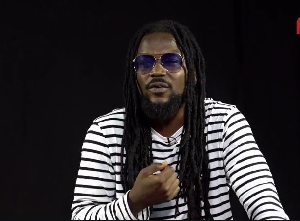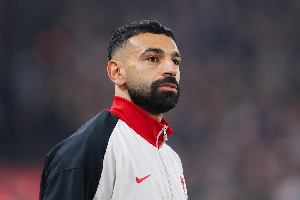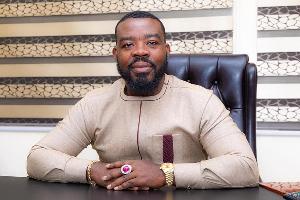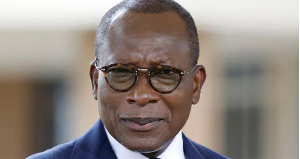Before we sit, Samini wraps up with the tapeline-bearing stylist who has trailed him here—stretching out both arms for his measurements to be taken. An undertone discourse ensues between both men, interspersed with head nodding and wags of disrelish at a fabric texture or colour suggestion.
It is not long before they settle on a costume choice though. A fist bump follows, as does the parting exchange of “akye saaa,” the reggae singer’s catchphrase. The stylist disappears through the door he had come in.
I’ve caught Samini (a top-rate Ghanaian musician for almost 2 decades) briefly at the Django Bar in VGMA season—between his galvanising Vodafone eXperience performance, and the main ceremony this weekend.
The dreadlocked man’s eyes retain residual fatigue from eXperience, but his deep husky voice seems well-rested. Along the sleeve of his right hand, tattoos descend gently.
I break the ice with a comment about his comedic expertise, instead of the pito question.
Samini thunders with mirth when he admits that he can be a tease sometimes. While he never saw himself in a comedic career, he brags that he’s a natural funny man: “I don’t think it’s something you learn. If you’re born with natural humour, it comes when you vibe with people.”
Cartoons or stand-up?
Whatever the mood dictates, he says, but a comedy channel is most likely what you would find him watching on a random afternoon.
Since his eXperience showcase, the media has been awash—as usual—with glowing reviews of his performance. But as he tells me, it doesn’t surprise him at this stage in his career. To him, performance is the ultimate proof that an entertainer is truly consummate. Hence, why he would never “cut corners” when plotting his stage performances.
“I’ve seen it too many times to know—unless I’m not on bill. I know that I’m going to go there and deliver and get my audience excited. So, I don’t go there worrying about what someone else is coming to do on that platform. My thing is that I have to have a good night. I have to have a solid performance. The reviews have to be good because the audience came there to have a good time,” posits Samini in a matter-of-fact tone.
“I come to give you life. I come to give you energy!”
The spontaneity on stage makes it fun for me,” says the singer about freestyling. “If you’re able to say what you feel like—with melody to it, and the people find it amazing, I think it’s among the best things that can happen.”
Hotly anticipated and now part of his signature, Samini’s spirited freestyles are typically preceded by a command to the band he’s superintending over on stage. “Low! Low!” he would instruct. As the band tones down, Samini simmers with instant genius, harvesting what presently surrounds him as foliage: a hostile fan, malfunctioning pyrotechnics, the Tema Motorway…
When he’s moved, Samini is capable of wringing out as many rhymes from a single word as possible. If it’s an attribute we typically associate with rappers, then Samini may well be a rapper too, considering how surgically he takes words apart and reconstructs them.
Therefore, what led him into the tradition of freestyling? Did he start off rapping, for instance?
“I know rap,” Samini answers. He reveals that he’s peened rap both for himself and others, but doesn’t agree that his aptitude with the art of freestyling emanated from rap. He holds that freestyles (like humour) come to him naturally. “No matter the genre you’re into—if you’re able to tap into your mind and just freely deliver something spontaneous, that’s genius.”
“It’s some of the best moments for me when I’m onstage,” he reiterates cooly, leaving his actual emotions to his eyes.
These “moments” don’t merely extend to the audience, but also impact the band he’s performing with, for by watching them, one can tell that beyond backing Samini, they’re at a concert too, having as much fun as patrons.
Samini is amused by this observation of mine. He too regularly notices this about the band. “Sometimes I catch them watching me like they are also at a concert; mesmerised by how deep I go with the freestyle, or how long I would drag one song to do different things with it that we never rehearsed.”
“Okay, this guy is at it again,” the faces of band members often seem to say. “It’s all fun,” Samini chuckles again.
Rapt, I probe further into this man’s approach to the science of stagecraft, specifically how he manages the Samini—band—audience dynamic.
“It’s quite an interesting question,” says the musician, suddenly puzzled.
There isn’t really a concept to it, he notes. He will be unable to relate how it happens how it’s done.
“For a performer, it happens, but I can’t describe it to you.”
Experience and confidence cannot be overstated though, Samini stresses—“staying focused, knowing what you are about.”
“Experience is part of why we are here.”
And here I was thinking there’s a specific scientific formula.
“This is not science because what we create is not tangible,” Samini notices my surprise. “You feel it. Once you can’t walk to it and touch it, you have to treat it differently.
“There are special aspects of this thing that we do that…sometimes, it’s only performed before one can understand. When it’s time to describe it in words, that now becomes the work of observers and writers.
“For instance, if you’re watching someone’s painting, and the one that painted it is not around to describe it or explain to you what it means, whatever energy you get from that painting is part of why it’s a special piece.”
It was obvious from the release of Dankwansere, his landmark 2014 debut, that some of his highest moments were reggae moments. Why has it taken him 7 albums to submit a body of work specific to the island genre?
“The reggae genre it’s not just Ghanaian—it’s international. So, as a Ghanaian, when you’re coming in, you have to be careful how you package it and bring it.
Since the beginning of his career, Samini been in the pursuit of a good reggae CD, but had had to gradually introduce himself to Ghanaian music listeners with genres that they are used to. So he did more local stuff; ventured into hiplife and other popular pulses locally. Indeed, “African dancehall”—which is one way Samini labels his music—borrows from the concept of hiplife; i.e taking from a worldwide potpourri of sonic influences but impressing into it an original identity while at it.
“I’ve always had plans—I’ve always had the dream to have a solid reggae catalogue so that I could travel around the world and perform on reggae platforms, because I’m able to do it. If you have the ability, why not?
And where is he when he pens a reggae song?
A special place for sure: “Reggae comes with values. It’s different from dancehall, which is the club or active version of reggae. So certain things you can say on a dancehall track and get away with, you can’t necessarily say it on a reggae song—unless you don’t know what you’re doing. So when I’m writing a reggae song, I’m in my conscience a lot more.
“As a reggae artist, you would understand that—that is your zone.”
A cursory listen to Untamed, Samini’s first fully-fledged reggae album exposes excellent nods to various extensions of the genre: Lover’s rock, dub, Nyabinghi, and rockers. Replete with love songs as well as poignant portraits of everyday struggle, the 22-track piece is easily Samini’s best work yet. Barely weeks after its release, it was named Reggaeville Album of the Year. Instrumentation on the project—overseen by the Grammy-nominated LoudCity Music–is highly polished: the kicks carry a confident impact; bassline smooth and emphatic, and is complemented by horns that are both timely and alive. Most of all, the vocal harmony that the songs supply are impeccable.
Contrary to a suspicion I held coming into this conversation, there wasn’t an explicit intention to cater to all of reggae’s prongs. Actually, it started off with little structure, Samini reveals. “I just knew I was doing a reggae album. As and when the interesting rhythms were coming, it was up to me to choose which one I vibed to.
After everything, when we selected the songs, we ended up having such a wide variety of reggae songs that fall under different styles and phases of the reggae journey. It’s quite a deep album that I’m proud about because it started off on a very calm note, and ended the way I pictured it to be.”
He, however, concurs with my sentiment of Untamed being his best work yet—at least, “per where it’s reached from when we released it. The best is yet to come, but so far I think Untamed is here to open a lot more doors.”
For anyone who has followed his career closely, Samini has never been one to back out from a challenge; epitome of a bold fearless spirit. If his rivalries over the past four or five years do not demonstrate his “never scared” spirit, track 20 of his new album does. “I’ve never been scared a day in my life,” goes a line in the hook.
This attitude does influence the quality of his performances for sure—particularly amidst an antagonistic crowd, “because when you’re confident in what you’re doing and you’re ready, you don’t have reason to look at anyone else coming to that same platform. So, I go out there to deliver: to make sure my audience is excited—to make sure they go home well-fed.”
Speaking of unsympathetic audiences, a major one Samini had to overcome is one from 2013—The Guinness Big Eruption Concert, which many critics describe as the performance of his life. Held at the Ohene Gyan Sports Stadium, it featured global pop icons Akon, Big Sean, and Wizkid, but the show, because it happened around the climax of the biggest Ghanaian music rivalry in remembered history—his lyrical tussle with Shatta Wale—was really a battle between Ghana’s dancehall kings.
Samini recalls the concert as “one of those memorable moments” of his career, where his fate, relevance and strength were heavily questioned. “I had to come out there and prove for the whole nation to judge—so that life could go on.”
“The results of that show are why we are here today,” he declares boldly.
“That night, it was up to me to come out to the stadium or stay at home. The streets had been poisoned, and there had been a good number of years of falsehood and propaganda just for fun. It had gotten certain youth to believe certain things about me. So they had come out not caring about me. It was up to me to now to come tell them: ‘guys, calm down. It’s not that serious. Let’s have fun. Let’s do some music and go home.’”
He prevailed. Critics pronounced him the winner on the night, much to the chagrin of his opposition.
More importantly, “I was able to get them to drop all that and focus on music. I saw people in the crowd who had come with a certain intention, did whatever they were doing for five minutes, and then switched; took off their shirts and started waving to my music. ”
That night taught him a number of things.
One: “if you’re not strong enough to come and conquer a stubborn fan to get them on-board, you’ll get a stubborn fan to intimidate you to stop.”
Two: the sheer power of music as an instrument.
“If you’re here to do music, you have to use it to the best of its capability; you have to take it as far as you can. So if it’s to bring peace while you’re on stage and you realise trouble, you have to use the music to do that.
“You get people’s attention when you do that—so there’s no limit to what you can do with the music when you get people’s attention.”
Why did he go out on that night though? Why does he go out on nights like that, when some would say he is better off sitting home and drinking pito, his beloved millet/ sorghum-based beer?
“It takes bravery. It takes you knowing yourself, knowing what you represent.
I don’t think there was enough reason for me not to have gone. That’s why I went out there. That’s why I would always go. If it’s about myself and another entertainer going out there to entertain people, I don’t think there’s anything that should stop me from going out to play. Indeed, ‘dancehall calls for rivalry and battle. So with all that in mind, you should just always gear up and get ready.”
Admittedly, there was a phase during the cold war when he anticipated bellicose jingoism against him, but events from that fateful 2013 concert would also open his eyes to the Ghanaian music fan, and the mechanics of winning him over.
“The Ghanaian music fan is a lover of the hit song and what is happening at the moment. So if you get carried away by everybody dancing to your music, interpreting them all as your fans, you’re gonna get confused, because, once your music is not that song anymore, that person isn’t necessarily your fan anymore.
“When you see someone you expected to be so much about you all of a sudden being about somebody else, that’s when you realise that it’s about hit songs for the Ghanaian music consumer—not about individuals.”
But then, there is another kind of Ghanaian fan, Samini goes on: he has sworn allegiance to a particular individual. He nods to every artist’s music alright, but they know why he worships Musician A or Performer B. So, there’s the High-Grade Family, the Shatta Movement, Bhim Nation, Sark Nation etc.
“These are people that live and breathe your art form. That’s different from the average Ghanaian music fan.”
A fixture at the VGMAs for the better part of twenty years, Samini has nabbed multiple plaques and nominations. This year, he’s up for “Artist of the Decade” –and though he faces stiff competition from Becca, Efya, Joe Mettle, No Tribe and Nacee, Okyeame Kwame as well as R2Bees, Sarkodie, Shatta Wale and Stonebwoy, he’s sure of emerging top, his confidence encapsulated it two simple words:
“It’s mine.”
He lives for big moments thus. It is how he has amassed outstanding credentials over the decades: a historic 2016 MOBO (Music of Black Origin), a 2009 MTV Africa Music Award for “Best Performer,” a 2010 Headies trophy, a 2011 Channel O Music Video Award for Most Gifted Reggae Dancehall Video Artist, multiple BASS awards among others.
Samini’s extensive catalogue demonstrates that he’s not merely an on-stage avatar, but also a magical songwriter, who is able to relate our human experience in a way that is honest, witty highly convincing, and spellbinding—sometimes to the point of tears.
Samini likens his concept of songwriting to a sacred vault. “There’s a box that you have to make sure that you don’t let certain things get to; you don’t let certain things out of easily.
“Once that box is intact, no matter how comfortable you get in life, you still have space to contain certain things and understand certain people and things, so that you’re able to write and be in people’s shoes.
“It’s a mind thing. You have to be able to protect the space where the creativity comes from.”
Again, “listen to people and try to live through their eyes and write for them—as if it was your experience.”
Yet again, because he has stacked extensive experience of his own during his journey, it is easy to remain grounded and “relate to the hustler and write about the hustler still. Otherwise, you’re gonna end up writing about your gold chain and your car because it makes you happy.
“You were singing about when you would get the next meal because that’s what you used to think about. Now that you have food, it doesn’t mean that everybody has food. So you have to still have that creative mind that makes you want to write like a hungry person.
“So yes, I have food but I don’t eat a lot. So that I don’t feel too full to be too lazy and sleepy. You have to sometimes be hungry to know how the hustler feels.”
I can tell—from how frequently Samini checks his phone that he’s running late for another engagement. I would let him leave, but not before he answers a final essential question: the pito conundrum.
Friday night or Saturday night?
He opts for Friday night.
The reason is simple: After a hectic working week, knowing that Saturday is a bit flexible, you can lift your calabash of pito to your waiting lips, savour a slow sip and sigh:
“Oh what a week!’
Samini was born Emmanuel Andrews Samini and hails from Wa in Ghana’s Upper-West region. Head honcho of the High-Grade Family, the singer who was recently installed ‘Pebilii Naa’ (King of the Rocks) is also credited as a ‘’star-maker,” having actively engineered the careers of contemporary stars like Kofi Kinaata, Kaakie, and Stonebwoy.
Having shared stages with Sean Paul, Akon, Kevin Little, Shaggy, Wayne Wonder, Damian Marley, Beenie Man, Jay-Z, Chaka Demus & Pliers, Culture (Joseph Hill) and Steel Pulse. Constantly trekking the world over with his music, Samini has collaborated with everyone from Sarkodie, to Grammy nominee, Rocky Dawuni, to Wizkid, to MI Abaga. Others include Etana, Busy Signal, Demarco, Anthony B, Steel Pulse, and DingDong.
Get Untamed here.
Entertainment of Wednesday, 22 May 2019
Source: enewsgh.com













